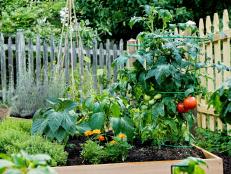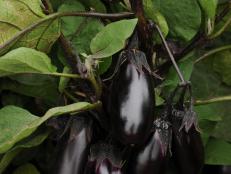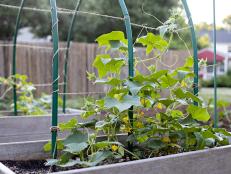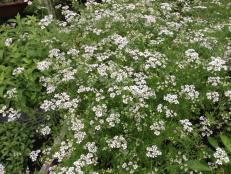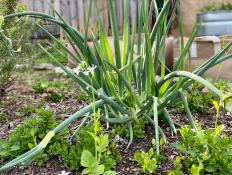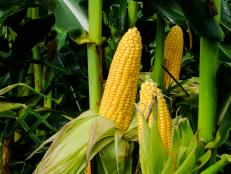Companion Planting for Summer and Winter Squash
For as many squash varieties as there are to grow, there are just as many problems that plague squash plants. Learn companion planting techniques to protect your precious squash.

When you hear the word “squash,” folks may picture a wide variety of different crops. Tender summer squash, long-lasting and flavorful winter squash, rotund pumpkins, and unusually shaped gourds are all technically squash, and although their fruit varies substantially in taste and appearance, growth and maintenance practices are fairly standard for squash across the board.
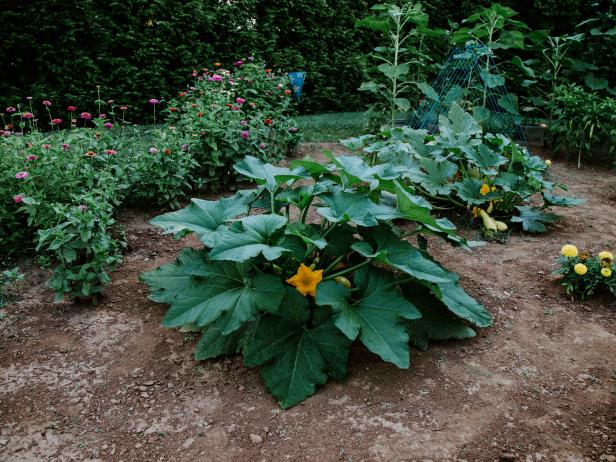
Shain Rievley
Zinnia flowers and marigolds grow alongside squash plants in this home garden. Planting a variety of flowers alongside squash invites pollinators as well as other beneficial insects to help out in your garden.
These close relatives share the genus Cucurbita and are collectively known as the cucurbits. Although cucurbits are some of the easiest vegetables to grow, they are susceptible to some serious pest and disease issues. Companion planting along with following best practices for cultivation is a great way to maximize the health and productivity of your squash.
What is Companion Planting?
Companion planting relies on plant diversity to maximize plant health and the health of the garden ecosystem by filling as many niches as possible with complementary species of plants. When we grow the same handful of species in the same area year after year, pests and disease populations can develop to the point that plant growth and vegetable productivity suffers. Simply growing a variety of different plants together goes a long way in alleviating pest and disease pressures for many vegetable crops.
Disguising Plants
In fact, some common and pernicious cucurbit pests, like aphids, rely on vision to locate crops. It’s much easier for these pesky bugs to find squash plants that are grown in bare soil because aphids are able to see the contrasting green foliage against the brown background of the garden bed. Interplant with companions or use a living mulch to camouflage squash and zucchini. Living mulch has other benefits, including feeding the soil, limiting weed competition, and providing habitat for beneficial insects. Take care to prevent the living mulch from competing with the crop for light, water, and nutrients.
Cucumber beetles and other pests that prefer or specialize in squash use fragrance to hone in on cucurbits by sensing cucurbitacin chemicals. This trait makes it easier for bugs to find squash – even after crop rotation. Even so, cucurbit pests also seem to have a harder time finding squash when it’s growing in a mixed planting with companion plants and living mulch.
Trap Cropping
Some squash varieties produce more cucurbitacin chemicals than others. If cucumber beetles, squash bugs, and other squash-specific pests are a problem in your garden, lure them away by growing a trap crop of a variety they will find more attractive around the perimeter of the garden, several feet away from other cucurbits. For best results, plant the trap crop a few weeks before other squash to give them a head start and remove pests and eggs when possible.
Protecting Pollinators
Cucurbit pests aren’t the only insects that selectively feed on squash, gourds, and pumpkin. Squash bees (Peponapis spp.) depend on pollen and nectar from cucurbit flowers to survive. Although squash blossoms can be pollinated by more species than squash bees, these host-specific pollinators are extremely effective at moving pollen from male to female squash flowers. In fact, squash bees account for the most pollination of cucurbit plants in gardens and fields where they are established. These native bees nest in the ground near their source of food (often right below squash plants), so avoid tilling or disturbing the soil to protect their habitat.
20 Incredible Squash Varieties 20 Photos
How many types of squash can you name? Summer or winter, add one of these colorful varieties to your garden.
Squash Companions
To Improve Growth
- The “Three Sisters” combination of squash, corn, and beans developed by indigenous peoples of the Americas is one of the oldest companion planting techniques in recorded history. Squash shades the soil and suppresses weeds, corn serves as a living trellis for beans, and beneficial rhizobia bacteria that live in bean roots fix nitrogen from the atmosphere for corn, squash, and beans to use. Researchers have found that squash grown with corn and beans actually have more visits from many predators than squash grown on its own. For best results, give corn a head start. Plant the beans and squash when corn seedlings are 4 to 6 inches tall.
- Grow a crop of beans or cowpeas between rows of pumpkin early in the season for a quick succession before pumpkin vines spread out. The early companion crop will cover and use the empty space and fix nitrogen from the atmosphere for the pumpkin crop to use.
- Cultivate a living mulch of yellow mustard around summer squash to improve crop growth, limit weed competition, attract beneficial insects, improve soil quality, and even limit pest and disease pressures.
- Grow squash and pumpkins after a winter cover crop such as winter wheat, oats, vetch, or crimson clover to improve the soil. Do not till the cover crop — just roll or cut back if needed, and leave the residue on top of the ground as a mulch.
To Attract Beneficial Insects
- In Plant Partners: Science-Based Companion Planting Strategies for the Vegetable Garden, companion planting expert Jessica Walliser recommends growing a diversity of squash species and varieties to support native squash bees throughout the season.
- Pair squash with cowpeas or grow a mixture of prolific flowering plants like buckwheat, dill, coreopsis, cosmos, and sweet alyssum to attract beneficial insects like pollinators and predators such as parasitic wasps, ladybugs, lacewings, and minute pirate bugs. Combine species that flower over a longer period and offer a variety of flower shapes to attract more beneficial insects.
- Grow squash and pumpkins in a living mulch of buckwheat, red clover, sunn hemp, or a mixture of oats and vetch to attract predators like lacewings, big-eyed bugs, minute pirate bugs, ground beetles, coccinellid beetles, Pennsylvania leatherwing, and spiders. These living mulches feed the soil and limit weed competition too.
To Manage Pests and Disease
- If your butternut squash is plagued by cucumber beetles, squash bugs, or squash vine borers, plant a perimeter trap crop of ‘Blue Hubbard’ squash to lure squash bugs away. Buttercup squash or zucchini will also work as a good trap crop for striped cucumber beetles.
- Grow pumpkins after a cover crop of winter rye and hairy vetch to feed the soil, limit the spread of diseases like Pseudomonas leaf spot and Fusarium fruit rot, and increase yield.
Tips for Growing Squash

Julie Martens Forney
Zucchini plants pump out squash and edible blossoms.
Squash are incredibly easy to grow. Sow seeds directly in the garden after the danger of frost has passed and the soil has warmed. Squash and pumpkins need at least 6 hours of sunlight, rich soil, and lots of room to roam. Space traditional rambling vines at least 5 feet apart and bush varieties 3 feet apart.
Water consistently throughout the season to ensure good fruit development and healthy growth. If possible, run a soaker hose or drip line at the base of the plant to deliver water directly to the roots without splashing the leaves. Keeping the foliage as dry as possible will help control fungal problems like powdery mildew.
Summer squash, patty pans (or “scallop squash”), and zucchini (all Cucurbita pepo) are picked as immature fruits, typically when they’re about 4 to 6 inches long. This means that these crops are usually ready to harvest 45 to 60 days after planting. The more you pick, the more these prolific growers will yield, so plan on harvesting a few times a week. When large fruit are left to mature, the plant will shift its efforts from flowering and fruiting toward seed development. Trim large leaves at the base of the plant to make it easier to spot developing fruits. Grow multiple successions of summer squash to keep production going through the season and into the fall.
Good things come to those who wait, and winter squash (Cucurbita moschata), gourds (C. argyrosperma) and pumpkins (C. maxima and some C. pepo and C. moschata) fruits require some patience on the gardeners’ part. Many varieties need 80 to 120 days before fruit will be ready to harvest. Mature winter squash will have a strong, woody stem and firm, fully colored skin. The fruit will sound hollow when tapped. These tough fruits can be damaged by freezing temperatures, so harvest early if a hard frost is in the forecast.
Tips for Crop Rotation
Cucurbit crops (like cucumbers, melons, and squash) take up a vast amount of garden real estate, which means that crop rotation is not always practical for squash, gourds, and pumpkins. Plus, these vining crops make fantastic groundcovers around tall vegetables like corn, okra, and tomatoes. Keep track of what plants have grown in each region of the garden, and try to leave at least one season between cucurbits. Remove all plant debris from squash and their relatives at the end of each season to alleviate some pest pressures the following season.








